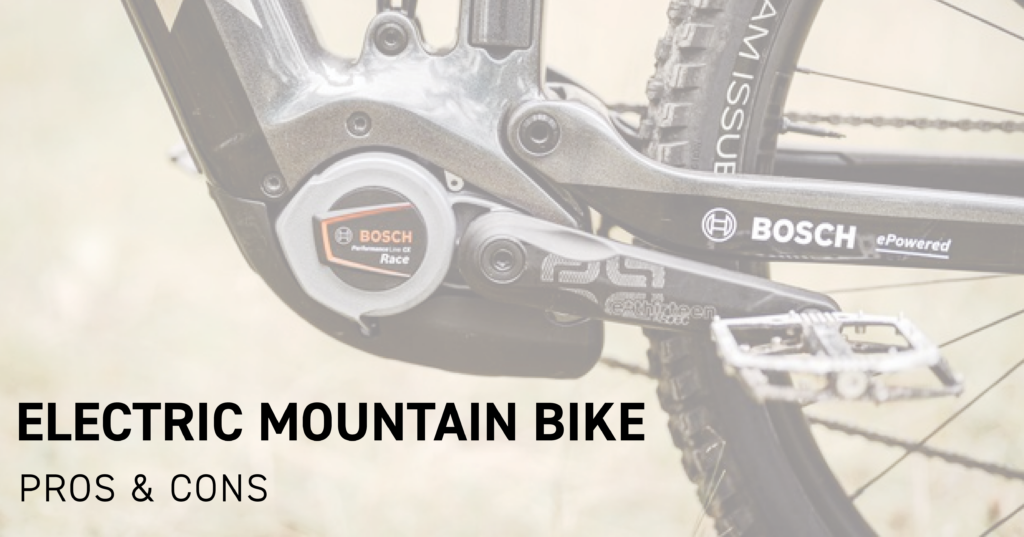Pros & Cons Of An Electric Mountain Bike (eMTB)
Electric mountain bikes (eMTB's) have been around for a number of years now and they keep gaining more and more in popularity. With advanced technology that is constantly improving (motors, battery life, etc.) and more brands producing eMTB's than ever before, we thought it would be a great time to go over all the pros and cons of an electric mountain bike.

Pros & Cons Of An Electric Mountain Bike (eMTB)
As mentioned above, electric mountain bikes have gained popularity in recent years, offering a new dimension to traditional mountain biking. Here are some pros and cons of electric mountain bikes to consider:
Pros:
- Assisted Riding: E-MTBs provide pedal-assist, which makes it easier to conquer steep inclines and challenging terrain. The pedal-assist reduces the physical effort required to ascend, and allows riders to maintain a more consistent speed on uphill sections. This can extend your riding range and help you tackle more difficult trails.
- Accessibility: E-MTBs can make mountain biking more accessible to a wider range of people, including those who may not have the physical conditioning for traditional mountain biking. Electric mountain bikes can appeal to older riders who may not have the same level of stamina and strength as younger riders. This extends the enjoyment of mountain biking into the later years of life. Furthermore, e-MTBs can be used as a part of rehabilitation for individuals recovering from injuries or surgeries. They provide a low-impact way to regain strength, mobility, and confidence on the trails.
- Extended Range: E-MTBs enable riders to cover longer distances in a single ride compared to traditional mountain bikes. This extended range can open up opportunities to explore more trails and areas in a single outing, especially when tackling hilly or rugged terrain. With the extended range e-MTB riders can now explore more remote and less-traveled trails, reaching areas that might be otherwise inaccessible within a single ride. This opens up new opportunities for adventure and discovery. Trail variety is another advantage. The extended range of e-MTBs enable riders to experience a wider variety of trails and terrains in a single ride. Riders can switch between technical trails, flowy singletrack, and challenging climbs without worrying about running out of battery.
- Equalizing Fitness Levels: E-MTBs can level the playing field for riders with varying fitness levels. Friends and family members with different levels of fitness can ride together, as the e-MTB allows riders to adjust the level of assistance to match their abilities. Slower riders can run on high assist levels, while fitter ones can turn them down, which allows people of varying abilities to ride together.
- Fewer Recharge Stops: With a longer range, riders need fewer recharge stops during their rides, which saves time and allows for a more continuous riding experience.
- Shuttle Yourself: A lot of riders shuttle with vehicles, but the e-MTB eliminates the need for that. With an e-MTB you can shuttle yourself and don't have to rely on multiple friends and figuring out vehicle logistics. You can now do it by yourself or with a friend without needing a whole crew. It also improves the experience further by allowing you to ride more. You can stay on your bike as you pedal up as opposed to getting off your bike and loading it in vehicles to drive back up.
- Encouraging Beginners: E-MTBs can be less intimidating for beginners, allowing them to build their skills and confidence on the trails without the fear of being left behind by more experienced riders.
Cons:
- Cost: E-MTBs tend to be more expensive than traditional mountain bikes due to the added electric components. With the additions of electronics, a motor, and battery, it can add roughly $4,000 to the cost of your bike. Electric mountain bikes are fun but not cheap.
- Harder on Components: E-MTBs tend to be harder on drivetrain components, wheels, brakes and tires. Expect to go through more of these items due to the extra power, weight and mileage you'll get with an e-bike.
- Weight: E-MTBs are heavier than regular mountain bikes due to the battery and motor, which can make them more challenging to transport and handle. On average, regular mountain bikes can weigh around 30 - 40 pounds, while e-MTB's on average weigh around 40 - 70 pounds. The weight difference can be extreme and you will notice it will riding and loading/unloading your bike.
- Maintenance: Electric components can require more maintenance and may be more complex to repair than traditional bike parts. If a motor or battery fails it is not as easy to replace or fix as opposed to non-electrical components.
- Battery Range: The range of an e-MTB depends on the battery capacity and usage. Long rides may require spare batteries or careful management of power. You also have to remember to charge your battery after every ride. Your electric mountain bike won't be useful if you go for a ride and realize once you're out that your battery is dead or low.
- Dependency on Technology: E-MTBs rely on electronic components, which can malfunction or become obsolete. Riders may become dependent on the electric assist as well. There are also apps, bluetooth paring, software updates, and other electronics to deal with when switching to electric mountain bikes. While most of this is strait-forward and easy to use, nothing is foolproof with electronics as issues can arise at anytime.
- Trail Etiquette: Some traditional mountain bikers and trail purists may view e-MTBs as disruptive to the sport and to the environment due to their potential to increase trail congestion. Arguments have also been made that due to the increased weight of e-MTB's, they are harder on trails and can erode corners quicker. The resulting damage can cause more trail maintenance as a result. Keep up-to-date on best practices for e-MTB use and trail etiquette. Attend local trail meetings or join trail advocacy groups to stay informed and contribute to responsible trail use. Show respect to other cyclists, whether they are riding e-MTBs or traditional bikes. Uphill riders generally have the right of way, so yield to them when descending.
- Regulations: Different regions and trails may have varying regulations regarding the use of e-MTBs, including where they are allowed and under what conditions. Some regulations may restrict e-MTB access to certain trails or areas, limiting where riders can enjoy their e-MTBs and potentially excluding them from some popular trails. It's important to note that regulations are often put in place to strike a balance between safety, environmental conservation, and responsible trail use. While there can be drawbacks to some regulations, they are intended to ensure that e-MTBs are used in a way that is considerate of other trail users, minimizes environmental impact, and promotes safety. To navigate these regulations effectively, e-MTB riders should educate themselves about local rules, engage in advocacy efforts, and be considerate trail users to promote positive relationships with other outdoor enthusiasts. Additionally, staying informed about changes in regulations and working with local trail organizations can help riders adapt to evolving e-MTB rules.
Our Take
Electric mountain bikes can offer numerous advantages, including enhanced accessibility and extended range, but they come with some drawbacks, such as increased cost and maintenance. If you can afford the extra costs and are ok with the increased maintenance, then we would recommend trying out an electric mountain bike. They have many advantages as mentioned above and they are just downright fun at the end of the day. We feel that cost is the biggest disadvantage, but if you can overcome this barrier, e-MTB's really are worth it at the end of the day. Ultimately, whether an e-MTB is right for you depends on your riding style, fitness level, and personal preferences. It's essential to consider these pros and cons and try out an e-MTB before making a decision.
In need of some new mountain bike parts or looking to upgrade? Shop our full selection of mountain bike parts here. We stock brakes, cassettes, derailleurs, shifters, chains, handlebars, stems, and much more! Remember that we offer free shipping on all orders over $149CAD and that all orders are processed and shipped within 24 business hours. Spend less and ride the best with TBS Bike Parts!
